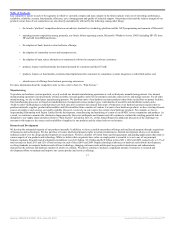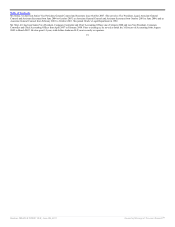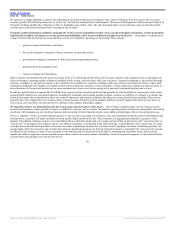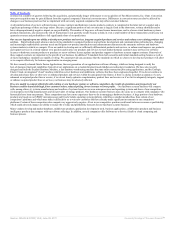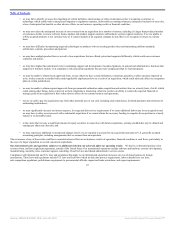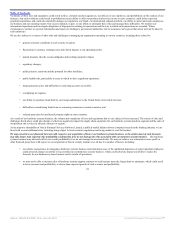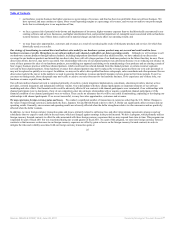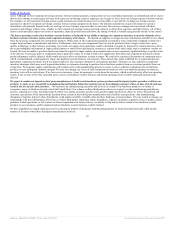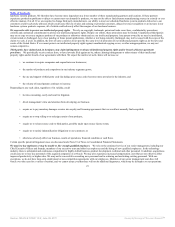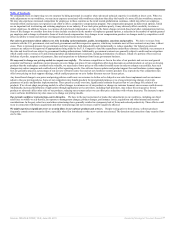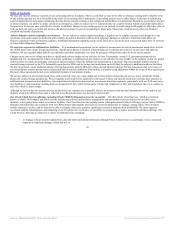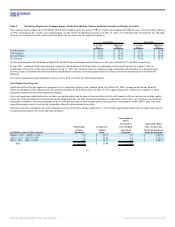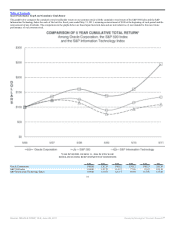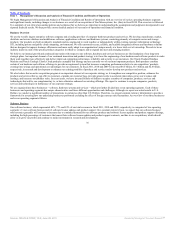Oracle 2010 Annual Report Download - page 30
Download and view the complete annual report
Please find page 30 of the 2010 Oracle annual report below. You can navigate through the pages in the report by either clicking on the pages listed below, or by using the keyword search tool below to find specific information within the annual report.
Table of Contents
losses. Although we have resumed our foreign currency forward contract program, a large portion of our consolidated operations are international and we expect
that we will continue to realize gains or losses with respect to our foreign currency exposures, net of gains or losses from our foreign currency forward contracts.
For example, we will experience foreign currency gains and losses in certain instances if it is not possible or cost effective to hedge our foreign currency
exposures or should we suspend our foreign currency forward contract program in the future. Our ultimate realized loss or gain with respect to currency
fluctuations will generally depend on the size and type of cross-currency exposures that we enter into, the currency exchange rates associated with these
exposures and changes in those rates, whether we have entered into foreign currency forward contracts to offset these exposures and other factors. All of these
factors could materially impact our results of operations, financial position and cash flows, the timing of which is variable and generally outside of our control.
The future operating results of our hardware systems business will depend on our ability to manage our component inventory to meet the demands of our
hardware systems customers and to avoid component inventory write-downs. We depend on suppliers to design, develop, manufacture and deliver on a timely
basis the necessary components for our hardware products. While many of the components purchased are standard, some components (standard or otherwise)
require long lead times to manufacture and deliver. Furthermore, there are some components that can only be purchased from a single vendor due to price,
quality, technology or other business constraints. As a result, our supply chain operations could be disrupted or negatively impacted by natural disasters such as
the recent earthquake and tsunami in Japan, political unrest or other factors affecting the countries or regions where these single source component vendors are
located. We may be unable to purchase these items from the respective single vendors on acceptable terms or may experience significant delays or quality issues
in the delivery of necessary parts or components from a particular vendor. If we had to find a new supplier for these parts and components, hardware systems
product shipments could be delayed, which would adversely affect our hardware systems revenues. We could also experience fluctuations in component prices
which, if unanticipated, could negatively impact our hardware systems business cost structure. These factors may make it difficult for us to plan and procure
appropriate component inventory levels in a timely fashion to meet customer demand for our hardware products. Therefore we may experience component
inventory shortages which may result in production delays or customers choosing to purchase fewer hardware products from us or systems products from our
competitors. We negotiate supply commitments with vendors early in the manufacturing process to ensure we have sufficient components for our hardware
products to meet anticipated customer demand. We must also manage our levels of older component inventories used in our hardware products to minimize
inventory write-offs or write-downs. If we have excess inventory, it may be necessary to write-down the inventory, which would adversely affect our operating
results. If one or more of the risks described above occurs, our hardware systems business and related operating results could be materially and adversely
affected.
We expect to continue to depend on third party manufacturers to build certain hardware systems products and third party logistics providers to deliver our
products. As such, we are susceptible to manufacturing and logistics delays that could prevent us from shipping customer orders on time, if at all, and may
result in the loss of sales and customers. We outsource the manufacturing, assembly and delivery of certain of our hardware products to a variety of
companies, many of which are located outside the United States. Our reliance on these third parties reduces our control over the manufacturing and delivery
process, exposing us to risks, including reduced control over quality assurance, product costs, product supply and delivery delays as well as the political and
economic uncertainties of the international locations where certain of these third party manufacturers have facilities and operations. Any manufacturing
disruption or logistics delays by these third parties could impair our ability to fulfill orders for these hardware systems products. If we are unable to manage our
relationships with these third parties effectively, or if these third parties experience delays, disruptions, capacity constraints, regulatory issues or quality control
problems in their operations, or fail to meet our future requirements for timely delivery, our ability to ship and/or deliver certain of our hardware systems
products to our customers could be impaired and our hardware systems business could be harmed.
We have simplified our supply chain processes by reducing the number of third party manufacturing partners on which Sun had historically relied and the
number of locations where these third party manufacturers build our
26
Source: ORACLE CORP, 10-K, June 28, 2011 Powered by Morningstar® Document Research℠



